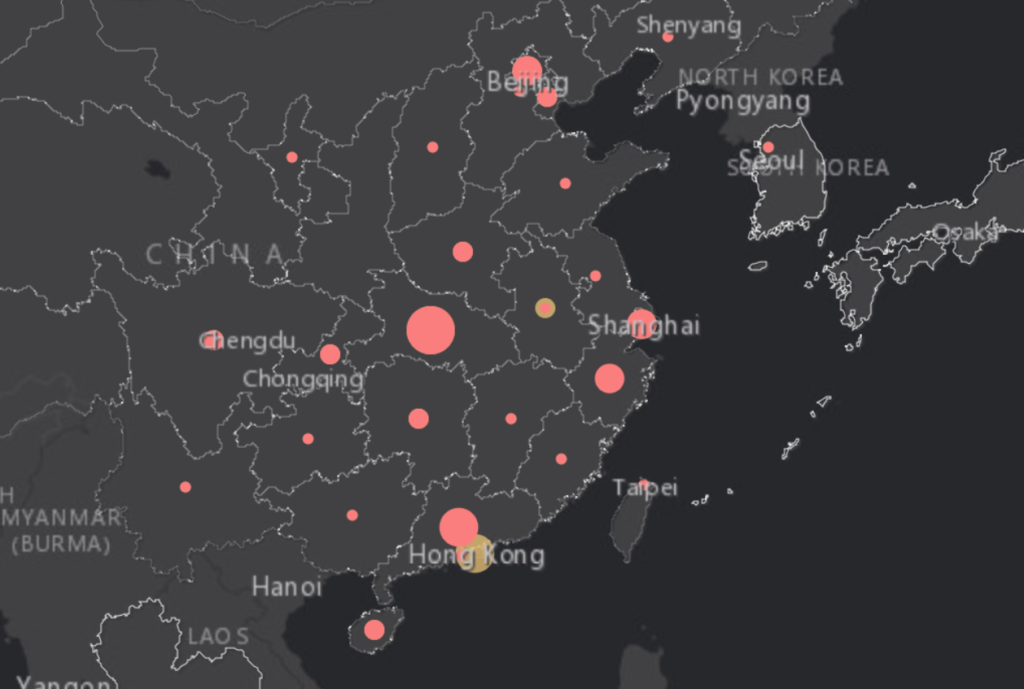We are seeing a decrease in the 2nd derivative, or the rate of growth of the growth rate. This is a leading indicator.
[...]
My scenario is mostly for illustration purposes, sure many factors can complicate response and resources, if things get extreme. But in developing nations we're not close to that.
I purposely am not trying to make a call on what the overall mortality % of the virus will be.
[...]
I have enough leading data that enough of the cases are past their most dangerous points. That said, one or two deaths would not invalidate the model, especially as international cases grow. The math is fairly similar, because (say for the 10% case. 0.999 is similar to 0.9100).
[...]
Someone asked me if I see a big risk of this breaking out everywhere in the rest of the world. I actually do not. So we think about infection phases in generations. The order can be roughly broken down as:
- 1st Generation: Infections directly from the source, eg. Wuhan Seafood market. Roughly end of Nov to end of Dec.
- 2nd Generation: Infections from those to people in Wuhan who did not visit the site. Roughly mid-Dec to likely peaking with Wuhan general announcement on Jan 15.
- 3rd Generation: Infections across China and Internationally as Wuhan population travels. Roughly early Jan to peaking just before Wuhan travel shutdown, Jan 23rd.
- 4th Generation: Local infections from 3rd Gen, in other Chinese provinces and h2h in other countries.
Adjusting for the 95%ile incubation period and reporting lag in different countries, right now most of 3rd generation infections internationally should have reported and is in process of being tested, and we're seeing the reports of 4th generation in early reporting developed nations with low reporting lag (Japan, Germany, France). 3rd generation was the most likely to lead to a surge internationally. And these numbers are fairly trustworthy, since they come from international CDC instead of China, and statistically they are roughly confirmed by our models (though with low population samples tbf).
And without a 3rd generation surge, we wouldn't see that large of a 4th generation surge, since each has to be infected by the previous generation.
So the trajectory looks ok so far. Are some countries riskier than others? Yes. Is there overall non-zero risk of a global epidemic? Certainly. But so far we are not heading in that direction, data-wise.
[...]
I am not making a definitive "ALL CLEAR" call here - just commenting on the current trajectory of the data.
Next week's data is probably the most important we've had so far for determining a lot of metrics since we start getting data from after the travel ban.
[...]
I'm not unconcerned for less fortunate countries, and this is indeed why WHO declared a global emergency, to allow those countries better access to funding and resources to fight this.
Interestingly, one advantage many other poor countries have is that they are mostly located in warmer, more humid climates like Africa, SE Asia, Latin America, etc. Coronaviruses tend to have various disadvantages propagating in those regions, which is why they are so coincidental with the Northern Hemisphere flu cycle. See:
The Effects of Temperature and Relative Humidity on the Viability of the SARS Coronavirus Association between viral seasonality and meteorological factors
[...]
Mutations could change anything at any time, sure, but is a purely random stochastic function that we don't spend much time on.
People love to talk about mutations because they've seen it in movies, or video games, and it's just a very scary "unknowable unknown" factor. Mutations do happen with RNA viruses, but frankly, could do all kinds of things. Both the flu and HIV have been around and have gone through hundreds of mutation cycles, it's actually pretty rare that the mutation does something crazy powerful to it. Antigenic shifts happen all the time.
How Flu Viruses Can Change
[...]
The German case is interesting for sure. I think they've been just inundated with requests since they published. Being on the statistics side I'm not sure what to make of it, since it's still few data points and a little unclear how exactly patient 3 and 4 were in contact with patient 1 vs the index. Did the index patient visit their office? Did they use the same conference room one after another? Door handles? etc.
Anyway I think a lot of teams are looking into this right now.
[...]
I was purposely trying to get to a balance between simplification and readability, and I see now several of my examples may be TOO simplified, despite my attempts to add disclaimers. A LOT of people have pointed out the very very simplified fatality model, but my point was that it actually doesn't make much difference if you shock it by a healthier cohort. Do you think it's better to just take that out?
One thing we 100% agree on is that:
The truth is that the confirmed infection rates from China have been capped by the availability of test kits for days, that reported death rates are likely to be substantial underestimates, that we have very little high-quality data to draw on at this point.
This is what I was talking about in 5) and 6), and I mention just those points.
[...]
I have more detailed case data than the public, and higher confidence interval on the recovery procedure of those cases. Some have largely recovered and are simply waiting to be cleared of the virus so there's no retransmission risk.
[...]
"It looks like the 2nd derivative of potential close contacts increased on 1 Feb? It's now 163844 vs. 136987 the day before. "
Yea, of course my one data point is immediately invalidated. You are correct that it's surged again today. The trend is still ok, and some other measures did moderate today, like suspected cases and fatalities, but I agree that my positivity attempt is sorely challenged by this data.
Of course it'd bite me in the face on the day I post it publicly. I may consider editing the post.
Anyway fortunately most of the other data points continued to inflect.
[...]
There was a cover-up in the first month and a half or so of the Wuhan outbreak by local, provincial governments at least. (I know there's some finger pointing now, but frankly I don't know how high up it was).
It is both a great shame and tragedy and this outbreak could have been stopped much faster with less effort if not for this deliberate coverup.
What I meant there is, is there a current cover-up responsible for the divergence in data TODAY. And my point is, it doesn't really matter, because actually there's other issues with the data.
[...]
Honestly we should see in the data next 2 weeks if containment has failed or succeeded in China ex-Hubei.
[...]
I am not aware of mutations though honestly I'm not at the cutting edge of the genomics team. It is certainly a risk, but an almost purely stochastic one that I can't do anything about. We'll react if it happens.
[...]
There may be many factors why it's more rampant in Wuhan. such as:
- Chinese that are traveling internationally are the ~1-5% wealthiest of China. Therefore they are also likely to be healthier and have better hygienic care, and better about self-reporting. (Yes exceptions exists, there are *ssholes everywhere)
- Chinese populations, especially in the industrial heartland near Wuhan, are more susceptible to respiratory disease due to the highly polluted air. Almost everyone has the lungs of a casual smoker, and this is before they start actually smoking.
- It's possible other factors in China are helping spread this fluid-borne virus. For example, cheaper Chinese bathrooms are designed with negative pressure systems that can allow virus spread between units in an apartment. This was an issue during SARS, and may be here as well.
[...]
Infection vector seems to require very close contact and a high viral load, eg among families, roommates, face to face coworkers, or at hospitals. So far airborne infection risks (such as on planes) have been very small.
There was a good twitter post from BC's CDC
[...]
2 months is a long time away and we'll have a lot more data by then about risks. 1 of 2 things will happen by then:
- The risk remains low/minimal and you'll be fine to go.
- The risk rises drastically in one of those countries, in which case your airline should allow you to cancel your ticket once this information known.
So, no need to worry right now.
[...]
I believe for now, several hospitals in Wuhan and Hubei are classifying it as such, which is why you're seeing mostly deaths there. Statistically, even for later-infection cohorts, deaths should have risen higher in other provinces by now but are probably under-reporting.
Last I had heard, some hospitals in Wuhan had gotten into sharp disagreement with the government over this death categorization issue.
[...]
China is building multiple quarantine hospitals in response to this, not regular hospitals.
These are basically 1-floor structures with plumbing and electricity, made with mostly prefabricated wall and floor pieces designed to more easily segregate a high number of infectious patients from other hospital patients and reduce cross infection risk. You can easily google pictures and videos as it's a popular propaganda item.
It's not surprising at all that they're doing this, because this was their playbook during SARS too, and it's believed to have helped.
How China Can Build a Coronavirus Hospital in 10 Days
[...]
China has released case data for about ~1100 patients last I know to international researchers, but not publicly.
However while fairly rare, the virus has been detected in children and even infants. I would not say young people always recover off the top of my head, but certainly have a much better prognosis than anyone older and with more complications.
[...]
I'm sorry if that section is misleading, I'm open to revising the titles.
In my post history, you'll see I've been quite vocal about the extent of the initial Wuhan coverup.
I'll paste one such message below:
There was a cover-up in the first month and a half or so of the Wuhan outbreak by local, provincial governments at least. (I know there's some finger pointing now, but frankly I don't know how high up it was).
It is both a great shame and tragedy and this outbreak could have been stopped much faster with less effort if not for this deliberate coverup.
What I meant there is, is there a current cover-up responsible for the divergence in data TODAY. And my point is, it doesn't really matter, because actually there's other issues with the data.
[...]















